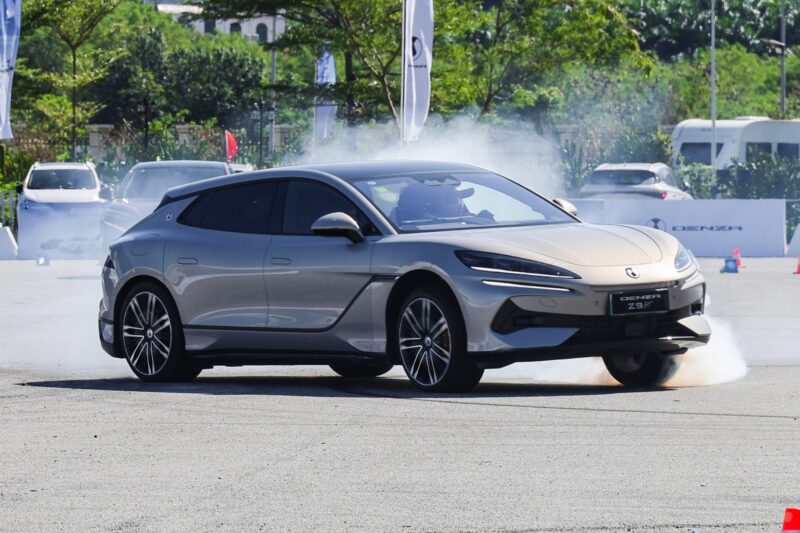At the launch of the Denza D9 in Kuala Lumpur, the automaker caught some of us (including yours truly) off guard when it used the Z9 GT to bring BYD’s Asia-Pacific Auto Sales Division General Manager Liu Xueliang onto the stage.
But the excitement didn’t stop there. The car demonstrated one of its standout features by executing a tank turn, which is essentially a 360-degree turn in the same spot. Picture a drift car performing a donut, albeit at a much slower speed and sans the billowing smoke.
Could this brief demonstration be an indication that the Z9 GT will soon enter the Malaysian market?
When questioned about this, BYD Malaysia’s Managing Director, Eagle Zhao, stated, “Soon, we will introduce more models in Malaysia, including the Z9 GT.”
The statement clearly illustrates Denza’s serious intentions regarding its presence in Malaysia. This is because unlike the D9, the Z9 GT currently lacks a right-hand drive (RHD) version.
By effectively saying that the model will be introduced here, Denza is indirectly signalling its readiness to invest significantly in entering RHD markets like Malaysia.
However, the question remains: can the Z9 GT entice Malaysian buyers, especially with the fierce competition from other, more established brands?
While it’s still too early to predict how the Z9 GT will do in our market, my first encounter with said car during a visit to Shenzhen, China, late last year showed that it has what it takes to shake things up the premium segment.
There was a test drive session but it was conducted in a rather small area with limited time. That said, I can conclude that the Z9 GT is indeed an exhilarating piece of machinery, not just in terms of performance but also on the design and feature fronts.
As you can see, the Z9 GT is a five-door wagon/shooting brake with a side profile that looks like it was cast in the same mould as the Porsche Panamera Sport Turismo.
Although its overall design may not match the German car’s grandeur, for those seeking a stylish shooting brake without breaking the bank, the Z9 GT seems like a fine candidate.
True to expectations, the car’s interior luxuriates in opulence and high-tech amenities that are sure to entice premium segment buyers.
It is important to note that the model is not solely developed for the Chinese market; it is also slated for European markets, where it will compete with legacy manufacturers like BMW, Mercedes-Benz, and Audi. So, the more kit, the better.
Notable features include Nappa leather upholstery, a panoramic glass roof, ambient lighting, two small fridges (one beneath the front armrest and another hidden between the rear seatbacks), and automatic doors that open and close by a mere press of a button—much like the i7.
The infotainment system is quite impressive as well. In addition to the digital instrument panel for the driver and a generously sized central touchscreen, the car also includes a display for the front passenger.
On top of these, it also comes equipped with a Devialet audio system (a French audio technology company) comprising a whopping 26 speakers and two wireless chargers on the centre console.
What about practicality, you ask? Golfers will surely appreciate the Z9 GT, as its boot space is ample enough to accommodate two golf bags when the rear seats are folded. Loading items into the boot is also made easy, thanks to the hatch that provides a wide opening.
Back to the aforementioned test drive, the media units provided were the PHEV variants featuring a 2.0-litre turbo four-cylinder petrol engine acting as a generator for three electric motors—one at the front axle, and two at the rear.
The combination yields a healthy total output of 870 PS, allowing it to accelerate from 0 to 100 km/h in a scant 3.6 seconds.
Also integral to this fifth-generation DM hybrid system is a 38.5 kWh LFP Blade battery, providing a pure electric driving range of 201 km (CLTC cycle) and a combined range of 1,100 km.
Needless to say, the Z9 GT moves like a rocket on wheels in a straight line but when facing tight turns, it does not exhibit the agility one might expect, despite equipped with rear-wheel steering and an air suspension system.
The primary factors contributing to this shortcoming are the size and weight of the Z9 GT. Measuring 5,180 mm in length, 1,990 mm in width, and with a wheelbase of 3,125 mm, this car is undeniably large. Weighing in at 2.9 tonnes, it comes as no surprise that it also struggled with the slalom test.
However, to be fair, the makeshift course was rather small for a powerhouse like the Z9 GT. Perhaps more comprehensive tests on highways or larger circuits like Sepang would do better justice to the car’s true capabilities.
For your information, in addition to the PHEV version, the Z9 GT is also available as an EV featuring three electric motors and a 100 kWh battery. This version boasts a total output of 963 PS, is capable of sprinting from 0 to 100 km/h in just 3.4 seconds and achieving a range of 630 km on a full charge.
Which version will be imported to Malaysia remains unclear but one thing for sure, the imminent arrival of the Z9 GT poses a challenge to other luxury brands.
